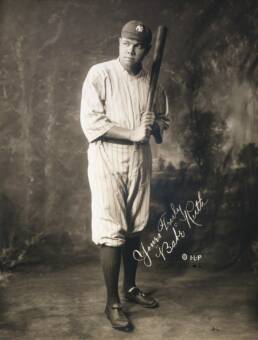These life stories may contain descriptions of childhood trauma and abuse, as well as images, voices and names of people now deceased. If you need help, you can find contact details for some relevant support services on our support page.
Celebrated American professional baseball player, Babe Ruth (1895-1948), was in the St Mary’s Industrial School for Boys in Baltimore from the age of seven.
George Herman Ruth was born in Baltimore, Maryland, to Kate and George Ruth, a tavern owner. He was one of eight children, although only two survived to adulthood. His parents sent George to St Mary’s Industrial School for Boys when he was seven years old. They were concerned their son was becoming a truant and troublemaker through lack of supervision.
St Mary’s was run by the Xaverian Brothers, a Roman Catholic order founded in 1839. It was named after Saint Francis Xavier, and specialised in education.
George became a “permanent ward of the school” (Rader) after his mother died from tuberculosis in 1912.
At St Mary’s, George was mentored by Brother Matthias, who encouraged the boy in his love of baseball. In 1914, Brother Matthias suggested to the manager of the Baltimore Orioles, Jack Dunn, that he come watch George play. Dunn watched George play “for less than an hour” (BabeRuth.com) before contracting him to play for the Orioles. On his first day of practice, George was apparently sneered at by a coach who called him “…another one of Dunn’s babes” (Nagle). Thus, George Ruth became Babe Ruth.
During his first season of playing for the Baltimore Orioles, Babe Ruth was sold to the Boston Red Sox.
Ruth soon became the best left-handed pitcher in baseball. Between 1915 and 1919 he won 87 games, yielded a stunning earned run average of only 2.16, won three World Series games (one in 1916 and two in 1918), and, during a streak for scoreless World Series innings, set a record by pitching 292/3 consecutive shutout innings (Rader).
In 1920, Babe Ruth was sold to the New York Yankees for $125,000. He “quickly emerged as the greatest hitter to have ever played the game” (Rader) and was soon nicknamed the “Sultan of Swat” by sports journalists. With Babe Ruth starring and the Yankees winning (including four World Series championships), the Yankees’ income increased so much they were able to build Yankee Stadium, “which opened in 1923 and became known as “the house that Ruth built” (History.com).
Babe Ruth was also key in revitalising baseball, with other players beginning to emulate his talent for hitting hard. He was popular with fans. Stories about his baseball feats often featured in newspaper articles and on the radio.
The uninhibited superstar gave regular interviews, posed for advertisements, acted in movies, and barnstormed the country showcasing his dazzling ability and flippant personality. He was the athletic embodiment of his times, the speakeasy-flapper-Jazz-Age hero. During the Depression, many Americans identified with his rags-to-riches story (Smithsonian).
Babe Ruth was a friend of Australian cricketing legend, Don Bradman, who was billed in the United States as “cricket’s Babe Ruth” (Sengupta). According to sports journalist Andy Bull, the pair watched a game of baseball with at Yankee Stadium during a 1932 tour of North America Australian cricketers including Arthur Mailey and Vic Richardson. Babe Ruth was astonished to learn that Bradman understood the rules of the game.
Bradman, looking sharp in his three-piece suit, was supposed to have said at one point “Jove! A double play!”…
“Hey! What’s this?” Ruth is supposed to have shot back. “I was told to point out the tricks of the game and you holler ‘double-play’? You don’t need any teaching!” (Bull).
Babe Ruth retired from baseball in 1935, after twenty-two years starring in the Major League.
“It wasn’t that he hit more home runs than anybody else,” said 1976 Spink Award winner Red Smith, “he hit them better, higher, farther, with more theatrical timing and a more flamboyant flourish” (Hall of Fame).
According to some US-based medical academics, Babe Ruth “contributed as much in death as he had in life” (Bikhazi, et al) because of the experimental cancer treatment he received in 1947 after being diagnosed with a nasopharyngeal carcinoma. Some say Ruth was also the first to receive both chemotherapy and radiation treatment for the particular cancer he suffered from. The treatment “worked dramatically—but only temporarily” (Altman). However, the knowledge acquired from Ruth’s case was instrumental in the development of what is now a standard treatment for nasopharyngeal cancer.
Babe Ruth died at Memorial Hospital in New York City on 16 August 1948.
A granite monument, a tribute to Babe Ruth, was unveiled at Yankee Stadium on 19 April 1949. The monument has been relocated to within the new Yankee Stadium, built across the street from the old one in 2008.
The Babe Ruth Birthplace Museum was established in the Baltimore house where Ruth was born and opened in 1973. Ruth’s wife, two daughters and sister were involved in choosing memorabilia for the exhibition.
National Babe Ruth Day is celebrated by baseball fans each year on 27 April.
References:
“1920 New York Yankees announce purchase of Babe Ruth.” History.com, 4 January 2021. https://www.history.com/this-day-in-history/new-york-yankees-announce-purchase-of-babe-ruth
Altman, Lawrence. “Ruth’s Other Record: Cancer Pioneer.” The New York Times, 29 December 1998. https://www.nytimes.com/1998/12/29/science/the-doctor-s-world-ruth-s-other-record-cancer-pioneer.html#:~:text=But%20unknown%20to%20many%2C%20Ruth,for%20his%20type%20of%20cancer.
BabeRuth.com. https://www.baberuth.com/
“Babe Ruth Baseball Superstar.” Smithsonian. https://amhistory.si.edu/sports/exhibit/superstars/ruth/index.cfm
“Babe Ruth. Right Fielder. Class of 1936.” National Baseball Hall of Fame. https://baseballhall.org/hall-of-famers/ruth-babe
Bikhazi, N., Kramer, A., and Spiegel, Jeffrey. “”Babe” Ruth’s Illness and Its Impact on Medical History.” Laryngoscope, vol. 109 (2009):1-2.
Bull, Andy. “Babe Ruth, Don Bradman and cricket’s uneasy relationship with baseball.” The Guardian, 6 May 2014. https://www.theguardian.com/sport/2014/may/06/the-spin-cricket-baseball-bradman-babe-ruth
Neagle, Jeanne. “Babe Ruth.” In Top 101 Athletes, edited by Britannica Educational Publishing Staff. United States: Rosen Publishing Group, 2013.
Rader, Benjamin. “Babe Ruth. American baseball player.” Britannica, 18 April 2023. https://www.britannica.com/biography/Babe-Ruth
Sengupta, Arunabha. “Cricket in America: Don Bradman meets Babe Ruth.” Cricket Country, 26 June 2016. https://www.cricketcountry.com/articles/cricket-in-america-don-bradman-meets-babe-ruth-150958
Smith, Martin. “In the footsteps of Bradman.” Cricket.com.au, 29 May 2016. https://www.cricket.com.au/news/feature/austraila-cricket-team-usa-new-york-city-don-bradman-babe-ruth-history/2016-05-29
Image available here.
